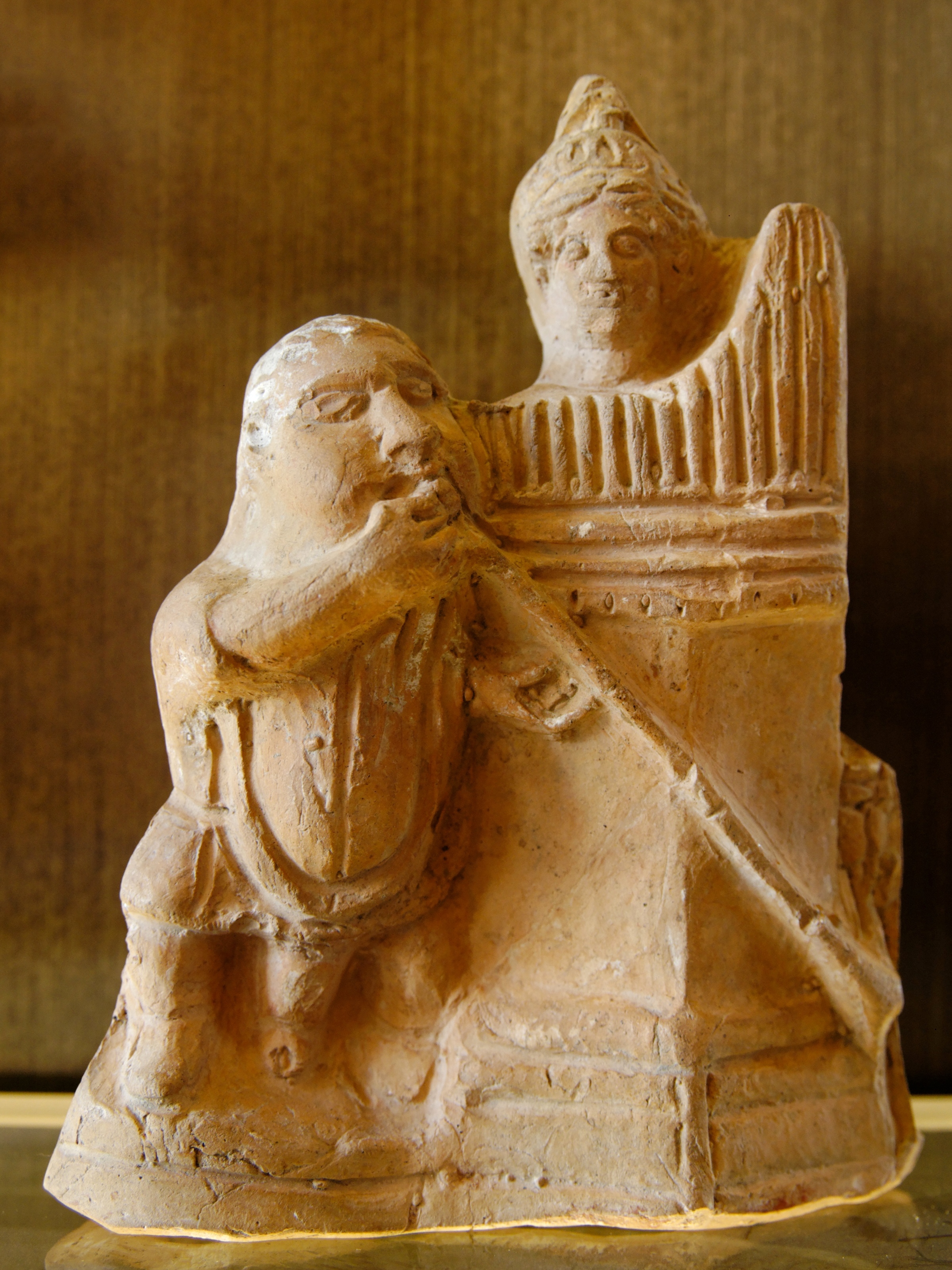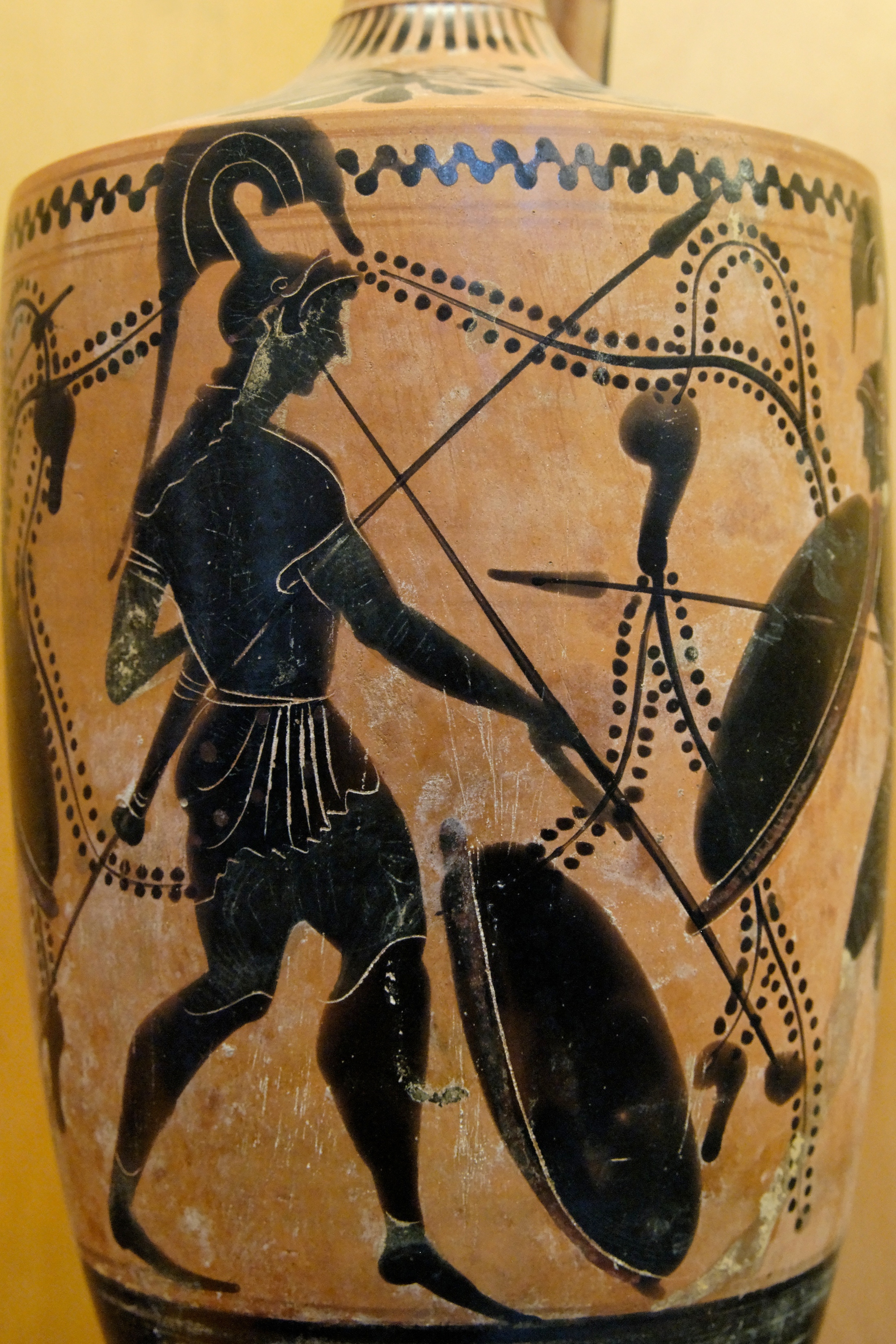Salpinx on:
[Wikipedia]
[Google]
[Amazon]

 A salpinx (; plural salpinges ; Greek σάλπιγξ) was a
A salpinx (; plural salpinges ; Greek σάλπιγξ) was a
 When encountered in Greek art and literature, the salpinx is usually depicted as being played by a soldier. Fifth century authors frequently associated its "piercing sound" with war; the instrument often being used for signalling, summoning crowds and beginning chariot races. This is supported in the writing of
When encountered in Greek art and literature, the salpinx is usually depicted as being played by a soldier. Fifth century authors frequently associated its "piercing sound" with war; the instrument often being used for signalling, summoning crowds and beginning chariot races. This is supported in the writing of

 A salpinx (; plural salpinges ; Greek σάλπιγξ) was a
A salpinx (; plural salpinges ; Greek σάλπιγξ) was a trumpet
The trumpet is a brass instrument commonly used in classical and jazz musical ensemble, ensembles. The trumpet group ranges from the piccolo trumpet—with the highest Register (music), register in the brass family—to the bass trumpet, pitche ...
-like instrument of the ancient Greeks.
Construction
The salpinx consisted of a straight, narrow bronze tube with a mouthpiece of bone and a bell (also constructed of bronze) of variable shape and size; extant descriptions describe conical, bulb-like, and spherical structures. Each type of bell may have had a unique effect on the sound made by the instrument. The instrument has been depicted in some classical era vases as employing the use of a phorbeia, similar to those used byaulos
An ''aulos'' (plural ''auloi''; , plural ) or ''tibia'' (Latin) was a wind instrument in ancient Greece, often depicted in art and also attested by archaeology.
Though the word ''aulos'' is often translated as "flute" or as " double flute", ...
players of the era. Though similar to the Roman tuba
The Roman (plural: ), or trumpet was a military signal instrument used by the ancient Roman military and in religious rituals. They would signal troop movements such as retreating, attacking, or charging, as well as when guards should mount, ...
, the salpinx was shorter than the approximately 1.5 meter long Roman tuba. A rare example of a salpinx, held at the Museum of Fine Arts, Boston, is unique in that it is constructed from thirteen sections of bone connected using tenons and sockets (with bronze ferrules) rather than the long, bronze tube described elsewhere. This salpinx is over 1.57 m long dwarfing the common salpinx which is estimated to have been around 0.8 – 1.20 m long.
Origin
Thetrumpet
The trumpet is a brass instrument commonly used in classical and jazz musical ensemble, ensembles. The trumpet group ranges from the piccolo trumpet—with the highest Register (music), register in the brass family—to the bass trumpet, pitche ...
is found in many early civilizations and therefore makes it difficult to discern when and where the long, straight trumpet design found in the salpinx originated. References to the salpinx are found frequently in Greek literature and art. Early descriptions of the sound of the salpinx can be found in Homer
Homer (; , ; possibly born ) was an Ancient Greece, Ancient Greek poet who is credited as the author of the ''Iliad'' and the ''Odyssey'', two epic poems that are foundational works of ancient Greek literature. Despite doubts about his autho ...
’s ''Iliad
The ''Iliad'' (; , ; ) is one of two major Ancient Greek epic poems attributed to Homer. It is one of the oldest extant works of literature still widely read by modern audiences. As with the ''Odyssey'', the poem is divided into 24 books and ...
'' (9th or 8th century BC), however, this Archaic reference is exceptional and frequent references are not found until the Classical period. Similar instruments can be found in Anatolia
Anatolia (), also known as Asia Minor, is a peninsula in West Asia that makes up the majority of the land area of Turkey. It is the westernmost protrusion of Asia and is geographically bounded by the Mediterranean Sea to the south, the Aegean ...
, Mesopotamia
Mesopotamia is a historical region of West Asia situated within the Tigris–Euphrates river system, in the northern part of the Fertile Crescent. Today, Mesopotamia is known as present-day Iraq and forms the eastern geographic boundary of ...
, and Egypt
Egypt ( , ), officially the Arab Republic of Egypt, is a country spanning the Northeast Africa, northeast corner of Africa and Western Asia, southwest corner of Asia via the Sinai Peninsula. It is bordered by the Mediterranean Sea to northe ...
, though the salpinx is most closely related to the Egyptian version. References to the salpinx in classical literature include mention of the instrument as ''tyrrhene'' a derivative of ''Tyrrhenoi'', an exonym
An endonym (also known as autonym ) is a common, name for a group of people, individual person, geographical place, language, or dialect, meaning that it is used inside a particular group or linguistic community to identify or designate them ...
often employed by the Greeks
Greeks or Hellenes (; , ) are an ethnic group and nation native to Greece, Greek Cypriots, Cyprus, Greeks in Albania, southern Albania, Greeks in Turkey#History, Anatolia, parts of Greeks in Italy, Italy and Egyptian Greeks, Egypt, and to a l ...
as an allusion to the Etruscan people. Bronze instruments were important among the Etruscans and as a people they were held in high regard by the Greeks for their musical contributions. The salpinx as an Etruscan invention is thus supported by the Greeks and various descriptions can be found among the authors Aeschylus
Aeschylus (, ; ; /524 – /455 BC) was an ancient Greece, ancient Greek Greek tragedy, tragedian often described as the father of tragedy. Academic knowledge of the genre begins with his work, and understanding of earlier Greek tragedy is large ...
, Pollux, and Sophocles
Sophocles ( 497/496 – winter 406/405 BC)Sommerstein (2002), p. 41. was an ancient Greek tragedian known as one of three from whom at least two plays have survived in full. His first plays were written later than, or contemporary with, those ...
. It is likely that the salpinx was introduced to the Greeks in some way through the Etruscans, however, scattered references to the salpinx prior to Greek contact with the Etruscans, as well as the myriad salpinx type instruments described by Eustathius of Thessalonia, suggests some small level of uncertainty in regard to whether or not the instrument came to the Greeks directly from the Etruscans or through some intermediary source.
Uses
 When encountered in Greek art and literature, the salpinx is usually depicted as being played by a soldier. Fifth century authors frequently associated its "piercing sound" with war; the instrument often being used for signalling, summoning crowds and beginning chariot races. This is supported in the writing of
When encountered in Greek art and literature, the salpinx is usually depicted as being played by a soldier. Fifth century authors frequently associated its "piercing sound" with war; the instrument often being used for signalling, summoning crowds and beginning chariot races. This is supported in the writing of Aristotle
Aristotle (; 384–322 BC) was an Ancient Greek philosophy, Ancient Greek philosopher and polymath. His writings cover a broad range of subjects spanning the natural sciences, philosophy, linguistics, economics, politics, psychology, a ...
who, in '' De audibilibus'', explained that salpinges were used as "...instruments of summons in war, at the games, and so on, not to make music." Aristides Quintilianus described the necessity of the salpinx and salpingtis (a player of the salpinx) in battle in his treatise, ''On Music''. He explains that each command to troops was given using specific tones or "melodies" played on the salpinx. This action allowed for an entire army to receive a command at once as well as provide a level of secrecy as these salpinx calls were specific to a group and would be unknown to an opponent. Yet despite its distinctive sound, the shrill blasts of the salpinx would have had a difficult time overcoming the clashing of metal, the cries of the wounded, the roars of aggression from rows of soldiers. This is why the salpinx was primarily used before battle to summon men to prepare for battle and to sound the charge.
Andrew Barker, however, describes a possible exception to the utilitarian usage of the salpinx referencing Aristotle, who wrote, "...that is why everyone, when engaging in revelry, relaxes the tension of the breath in playing the salpinx, so as to make the sound as gentle as possible." It is suggested here that the salpinx may have found use in festive occasions as well as war. This notion is corroborated by Nikos Xanthoulis in his article "The Salpinx in Greek Antiquity". Here, he draws particular attention to Aristotle's statement that "...participants of a komos
The ''kōmos'' (; : ''kōmoi'') was a ritualistic drunken procession performed by revelers in ancient Greece, whose participants were known as ''kōmasts'' (κωμασταί, ''kōmastaí''). Its precise nature has been difficult to reconstruct ...
unbend the tension of the exhaling air in the salpinx, in order to make the sound smoother." The komos, a street festival with music and dance, would require an "unbending of tension" in order to create a more pleasing tone thus indicating a usage for the instrument outside of the military. Another more universal function of the salpinx was to use it as a means of bringing silence to a rambunctious crowd or at a large gathering. This was both useful in a societal setting in places such as large assemblies and as a tool to quiet soldiers while a general addressed his men.
Modern
The sound of the salpinx was being digitally recreated by the Ancient Instruments Sound/Timbre Reconstruction Application (ASTRA) project which uses physical modeling synthesis to simulate the sound of the salpinx. Due to the complexity of this process, the ASTRA project uses grid computing on hundreds of computers throughout Europe to model the sounds. The Salpinx is part of the Lost Sounds Orchestra, alongside other ancient instruments whose sounds have been recreated by ASTRA, including the epigonion, theaulos
An ''aulos'' (plural ''auloi''; , plural ) or ''tibia'' (Latin) was a wind instrument in ancient Greece, often depicted in art and also attested by archaeology.
Though the word ''aulos'' is often translated as "flute" or as " double flute", ...
, the barbiton
The barbiton, or barbitos (Greek language, Gr: wikt:βάρβιτον, or wikt:βάρβιτος, ; Latin, Lat. ''barbitus''), is an ancient stringed instrument related to the lyre known from Greek literature, Greek and Ancient Rome, Roman classic ...
and the syrinx
In classical Greek mythology, Syrinx () was an Arcadian nymph and a follower of Artemis, known for her chastity. Being pursued by Pan, she fled into the river Ladon, and at her own request was metamorphosed into a reed from which Pan then mad ...
.
See also
* History of primitive and non-Western trumpetsReferences
External links
* http://www.tapsbugler.com/HistoryoftheBugle/HistoryoftheBugle2.html {{Trumpets Ancient Greek musical instruments Natural horns and trumpets